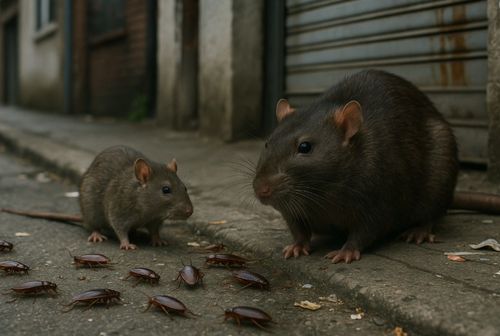為何相較於歐美日國家.大陸與台灣的老鼠跟蟑螂相當多?
首先,氣候和地理環境對鼠蟑繁殖影響非常大。台灣和中國大陸大部分地區屬於亞熱帶或溫帶氣候,氣溫高、濕度大,這種環境極適合老鼠和蟑螂生存與繁殖。相比之下,歐美一些國家因為冬天長且寒冷,能自然抑制這些害蟲的數量;而日本雖然氣候上也濕熱,但城市管理與居民個人衛生習慣相對嚴謹,因此害蟲問題受到較好控制。
再來談到城市結構與公共衛生。在中國大陸很多城市,特別是舊城區或人口密度極高的地方,建築老舊、下水道系統落後或維護不良,容易成為老鼠和蟑螂滋生的溫床。大陸幅員遼闊,農村與城市間發展不平衡,很多地方的垃圾處理體系還未全面完善,使得害蟲有充足的食物來源。台灣方面雖然都市化程度較高,但早期快速發展也留下不少基礎設施老化的問題,例如老舊公寓、狹窄巷弄,加上潮濕的環境,使得鼠蟑問題一直存在。
老鼠體型的差異也值得一提。中國大陸因為地大物博,環境條件多樣化,有些地區特別是北方或農村周邊的老鼠,食物充足、空間大,因此體型特別巨大,常見到所謂「田鼠」型的大型老鼠。相比之下,台灣因為地狹人稠,都市老鼠主要是以體型較小的「家鼠」為主,但即使如此數量仍相當可觀。
要解決這些問題,最關鍵的是從「源頭管理」做起。首先是改善城市的基礎設施,尤其是下水道、垃圾處理與公共空間的清潔,避免老鼠和蟑螂有藏匿與繁殖的空間。其次是加強垃圾分類與及時清運,減少食物殘渣裸露。居民本身的衛生意識也非常重要,包括食物收納、廚餘管理、家居清潔等都需要落實。此外,政府可以定期進行大規模滅鼠、滅蟑行動,並結合環保方式,如使用生物防治、設置防鼠設施、推行無毒驅蟲技術。若只依靠個人滅蟲,效果往往短暫且有限,必須是社區與政府合力推動才能長期見效。
從更深層角度來看,這其實是都市現代化與公共管理水平的縮影。城市越是重視細節管理,鼠蟑問題就越能有效被控制。這也是為什麼在一些歐美大城市,例如瑞士蘇黎世或日本福岡,很少能見到老鼠和蟑螂蹤影的主要原因。
First of all, climate and geographical environment have a significant impact on the reproduction of rats and cockroaches. Most regions of Taiwan and mainland China fall under subtropical or temperate climates, characterized by high temperatures and humidity, which provide an ideal environment for the survival and proliferation of rats and cockroaches. In contrast, some Western countries experience long and cold winters, which naturally help suppress the population of these pests. Although Japan also has a hot and humid climate, its strict urban management and residents' personal hygiene habits have kept pest problems relatively well under control.
Moving on to urban structure and public sanitation, many cities in mainland China—especially old districts or areas with extremely high population density—suffer from aging buildings and outdated or poorly maintained sewage systems, which easily become breeding grounds for rats and cockroaches. Due to the vast land area and uneven development between rural and urban regions, many places still lack a fully developed waste management system, providing pests with abundant food sources. In Taiwan, although urbanization is relatively advanced, the rapid development during earlier periods left behind numerous aging infrastructures, such as old apartment complexes and narrow alleys. Combined with the island's humid environment, rat and cockroach problems continue to persist.
The difference in rat size is also worth mentioning. Mainland China's vast and diverse environments allow for significant variations in rat populations. In particular, areas in the north or near rural regions often have larger rats, commonly known as "field rats," due to abundant food and wide living spaces. In contrast, Taiwan, with its limited land and high population density, mainly hosts smaller "house rats" in urban areas, although their numbers are still substantial.
To address these issues, the most crucial approach is to start with "source management." This includes improving urban infrastructure, especially sewage systems, waste management, and the cleanliness of public spaces, to eliminate hiding and breeding grounds for rats and cockroaches. Strengthening garbage sorting and ensuring timely waste disposal are also important to reduce exposed food scraps. Public awareness of hygiene must be enhanced as well, covering areas such as food storage, kitchen waste management, and regular home cleaning. Additionally, governments can organize large-scale rat and cockroach extermination campaigns and incorporate eco-friendly methods, such as biological pest control, installing rodent-proof facilities, and promoting non-toxic pest control technologies. Relying solely on individual efforts tends to provide only short-term effects; a coordinated effort between communities and government authorities is necessary for long-term success.
On a deeper level, pest control actually reflects the degree of urban modernization and the effectiveness of public administration. The more a city focuses on detailed management, the better it can control rat and cockroach problems. This explains why in some major Western cities, such as Zurich in Switzerland or Fukuoka in Japan, it is rare to see rats and cockroaches in public spaces.

- 1
- 2
- 3
- 4
